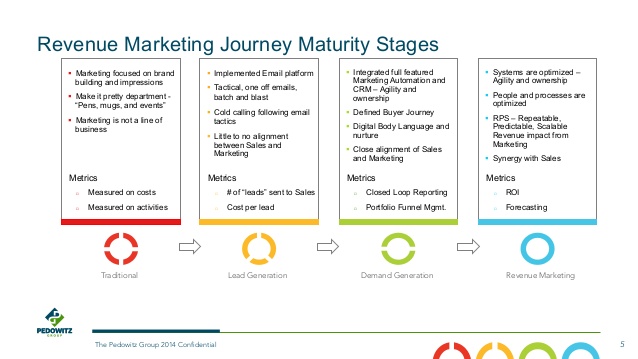The brilliant aspect of marketing is that the rules are not sacrosanct, there is no one silver bullet that solves all problems. But over the last decade, the attention of B2B marketers like us has increasingly shifted towards revenue generation. More and more marketing experiments, and marketing channels are being increasingly measured by how they contribute to improve signups, demo requests, request for quote, etc. In other words, these KPIs are indicators of contribution to driving revenue.
A quick look at the Key Result Areas (KRA) sheet of a marketer will give you an understanding of the part of the marketing organization they belong to in the company. For instance, if someone’s KRAs are in the area of PR, corporate communications — you know they are aligned to corporate marketing. Similarly, the ones aligned to product marketing have KRAs related to on-boarding, product adoption, etc.
But the question is how does each team contribute to revenue? Are the KPIs and KRAs of one team helping the other? One of the biggest points of contention between teams is attribution and outcomes, and more so for sales and marketing.
For instance, a marketing team might be happy if an email campaign had a high click-through rate, but it means nothing for the sales team. You need to be aligned to achieve a collective outcome.
Revenue is the common denominator
Marketing teams and sales teams now are working more closely than ever because of the realization that revenue is the common factor that binds them together. More and more companies are measuring their marketing teams based on their contribution to revenue.
Until a few years ago, there were very few companies that had revenue based titles in the marketing department. But now we have so many people with revenue marketing titles when we do a quick search on LinkedIn.
According to the Pragmatic Institute, roughly 85% of B2B marketers are feeling intense pressure to add direct revenue accountability to their job description.
Revenue marketing is an attempt to move marketing from being a cost center to a revenue center. At the core of revenue marketing is — to be able to build a repeatable set of processes and programs to drive customer acquisition and recurring revenue. Therefore, it isn’t just about top of the funnel activities or driving product signups, but also about improving revenue per customer account with customer marketing, upselling and cross-selling programs.
What makes it interesting is the need to build a predictable revenue flow into the organization. And that is possible only if you are able to map every marketing activity to a specific revenue objective and thereby a specific revenue outcome.
In fact, as organizations get more sophisticated, revenue marketing drives the sales pipeline. It also means the outbound sales calls slowly phases out, and outbound efforts tend to become more focused on building a strong partner channel and community. And to make this all meaningful, the goal setting in these organizations start with revenue goals and is then worked backwards to arrive at the marketing programs and the KPIs to get there.
Setting up the revenue journey
With marketing becoming more and more tech-driven, it has now become far more feasible to measure and track how campaigns perform in terms of customer acquisition. That said, one of the fundamental pain points for marketers is the inability to attribute marketing programs to outcomes.
A study contributing to the Heinz Annual marketing report suggests that 53% of marketers can’t measure or are unsure of their ROI.
So, when you go about building your revenue marketing engine, you need to:
- Focus the entire journey and programs based on revenue impact
- Make sure your sales, customer support, and customer success works as one team with your marketers
- Leverage martech effectively (doesn’t mean you buy subscriptions for a ton of tools that is never used by your team)
- Understand the current skills available, identify skills needed
- Set up the right KPIs and accountabilities to your team members
Therefore, it starts with understanding where you are in terms of revenue marketing maturity, where do you want to be (in what time period?), what you need to get there, and then get into the execution cycle.


For starters, let us look at having some core decision makers and contributors and the roles they will play in getting your revenue engine up and running.
Director or VP of Revenue Marketing: The primary responsibilities of the person in this role is to strategize demand generation and deploy a scalable revenue marketing architecture. It means the person in this role directs the team on the channels to engage with prospects and customers and oversee the lead funnel, makes sure campaigns are directly aligned to building pipeline, and thereby creates revenue impact.
Marketing Analyst: The title “Marketing Analyst” is a loosely used term by a lot of organizations around the world. In this context, the focus of the role is measuring campaign analytics over time and constantly reviewing the numbers. This role is super critical because of the shift from campaign efficiency metrics such as opens and CTRs to revenue metrics such as pipeline generated, signups effected, and so on.
Marketing Technologist: Technology is at the core of revenue marketing. On average, the mid-size firms tend to have 20-25% of their budget assigned for martech investments. So you need to be sure of what your must-haves are. For instance, if you have to run an effective ABM campaign, you need all the infrastructure set up from predictive intelligence, the right CRM, marketing automation, content distribution tools, analytics, and more.
The role of the marketing technologist is to play the role of a power user when it comes to running campaigns and make sure the team is leveraging technology in the most optimal way possible and thereby continuously contributing to refine the revenue metrics according to the business needs. More importantly, the key is to manage the quality of data effectively and formalize the data architecture that binds the sales and marketing tools across the organization.
Content marketers: Content will always remain the king even if the content formats keep changing and evolving. You need the right creatives and copies that lead to conversions, be it emails, websites, landing pages, ebooks, or more. You need quality content marketers who not only produce quality content but also distribute the content effectively to build awareness, interest, consideration and conversion. The key is to make sure that the content is customer-centric and not product-centric. It needs to be in the way customers would resonate with it.
Key questions to ask and measure, to make incremental progress
The four roles mentioned actually distributes itself across six key pillars namely: strategy, people, process, technology, customer, and results.
For instance, let’s take content marketing. You need to acknowledge that it is beyond producing great content. You need to tie the content marketing efforts to outcomes. The Forrester graphic below provides a great example.
The idea is to continuously measure where you stand and make incremental progress to get your organization to the next level of revenue marketing maturity, so that everything that you do contributes to revenue and growth.
So, here’s what to measure in each of the 6 pillars:
Strategy – where you want to be as an organization on the revenue marketing maturity path vs. how ready and aligned is the organization currently, how much of leadership buy-in is achieved, etc.
People – how is your revenue marketing unit structure, do you have all the resources for all the skills you need, have you set up the recruitment program, do you have a program for upskilling and talent management, etc.
Process – have you set up a customer acquisition to revenue process? Do you have a process set up for how things flow from marketing campaigns and demand generation to program management and onboarding to converting free customers to paid programs, customer success, etc?
Technology – assess your current tech stack and architecture on if you have the necessary technology and tools to support the customer journey seamlessly at each stage, if not – have you shortlisted the tools you need, and most importantly check how the technology adoption is across the different teams involved in the customer and revenue creation journey.
Customer – continuously measure if any part of the customer journey is broken, assess how well is the customer data managed, are you making sure that all the marketing efforts are on the identified customer persona only, what is the customer engagement rate, what is your NPS score, what is your churn rate, are you able to identify churn signals in advance, etc.
Results or outcomes – are you able to measure and attribute contributions to revenue at each stage? Are you able to measure improvement in operational efficiency, conversion rate, etc? In short – are you clear on what is working for you and what is not?
To sum up, the key is to set up your marketing operations in such a way that every team and every team member contributes to revenue and that it is measurable and attributable. If you can manage that, and continuously keep improving every moving part, you end up setting the revenue marketing flywheel in motion – from strategy to execution to revenue.
Download your free Revenue-Marketing Checklist/swipe file
Download “The Revenue Marketing Book”





Great post Yaag. For a Marketing newbie like me this is enlightenment material.
One thing i have always wondered in terms of terminologies. How would Digital marketing be different from Revenue marketing since the outcome in both cases happen to be getting predictable and measurable sales and tying it up with the Revenue goal.
Is it just usage and talking in different contexts?
Thanks for sharing this post again.
Thank you, Sriram. I’m glad you like the article. Well digital marketing is nothing but marketing using the digital medium. Whereas revenue marketing isn’t about medium, and instead about attribution. Digital marketing goals aren’t always revenue oriented. For instance, someone running an email campaign measures campaign success by open rate and click throughs, whereas it means nothing to a sales professional. Revenue marketing is a pledge towards having common goals that directly or indirectly contributes to revenue (which can include non digital marketing activities too)
Great! Loads of wisdom and tons of love and thanks.!!
[…] after I published my previous blog on setting up the revenue marketing engine, a lot of people reached out to me asking me to share about – how one can transition from their […]